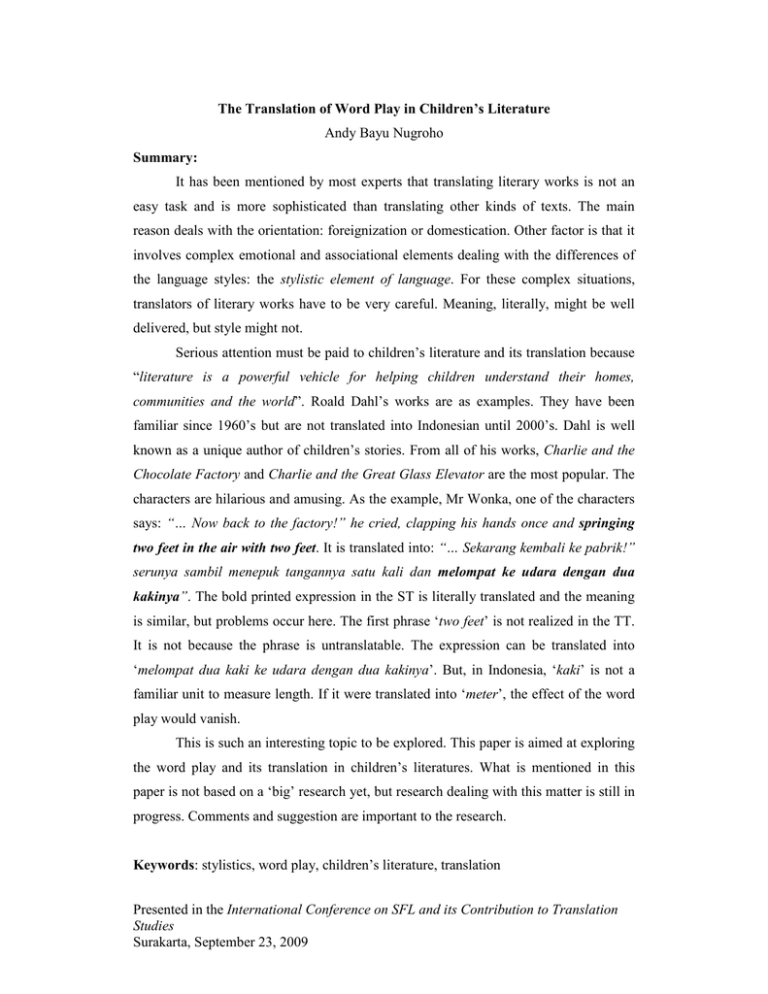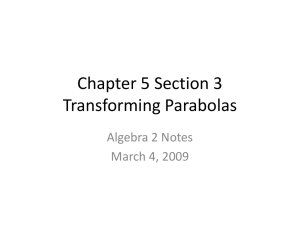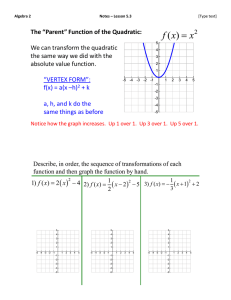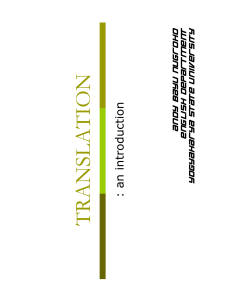The Translation of Word Play in Children’s Literature Andy Bayu Nugroho Summary:
advertisement

The Translation of Word Play in Children’s Literature Andy Bayu Nugroho Summary: It has been mentioned by most experts that translating literary works is not an easy task and is more sophisticated than translating other kinds of texts. The main reason deals with the orientation: foreignization or domestication. Other factor is that it involves complex emotional and associational elements dealing with the differences of the language styles: the stylistic element of language. For these complex situations, translators of literary works have to be very careful. Meaning, literally, might be well delivered, but style might not. Serious attention must be paid to children’s literature and its translation because “literature is a powerful vehicle for helping children understand their homes, communities and the world”. Roald Dahl’s works are as examples. They have been familiar since 1960’s but are not translated into Indonesian until 2000’s. Dahl is well known as a unique author of children’s stories. From all of his works, Charlie and the Chocolate Factory and Charlie and the Great Glass Elevator are the most popular. The characters are hilarious and amusing. As the example, Mr Wonka, one of the characters says: “… Now back to the factory!” he cried, clapping his hands once and springing two feet in the air with two feet. It is translated into: “… Sekarang kembali ke pabrik!” serunya sambil menepuk tangannya satu kali dan melompat ke udara dengan dua kakinya”. The bold printed expression in the ST is literally translated and the meaning is similar, but problems occur here. The first phrase ‘two feet’ is not realized in the TT. It is not because the phrase is untranslatable. The expression can be translated into ‘melompat dua kaki ke udara dengan dua kakinya’. But, in Indonesia, ‘kaki’ is not a familiar unit to measure length. If it were translated into ‘meter’, the effect of the word play would vanish. This is such an interesting topic to be explored. This paper is aimed at exploring the word play and its translation in children’s literatures. What is mentioned in this paper is not based on a ‘big’ research yet, but research dealing with this matter is still in progress. Comments and suggestion are important to the research. Keywords: stylistics, word play, children’s literature, translation Presented in the International Conference on SFL and its Contribution to Translation Studies Surakarta, September 23, 2009 BIODATA Name : Andy Bayu Nugroho, S.S. Occupation : Lecturer Institution : English Language and Literature Study Program of the Faculty of Languages and Arts, Yogyakarta State University (UNY), Yogyakarta, Indonesia; Also a student at Linguistics Study Program major in Translation of Program Pascasarjana UNS Surakarta, Indonesia Address : Ketingan Rt. 03 Rw.21 Tirtoadi, Mlati, Sleman, Yogyakarta, Indonesia Mobile phone : +6281328785230 E-mail : abenugroho_uny@yahoo.com andy_bayunugroho@uny.ac.id





